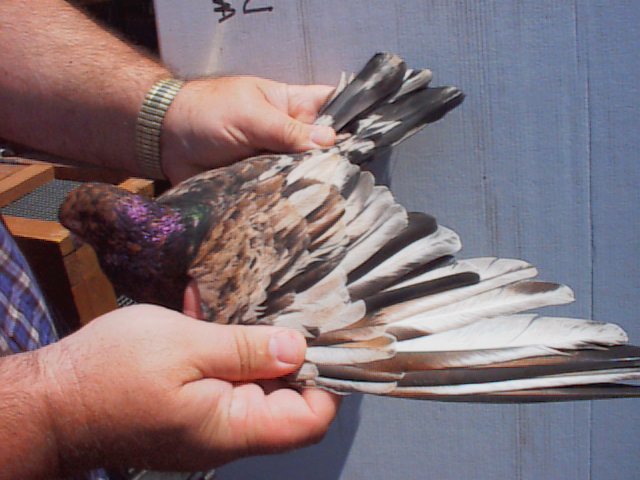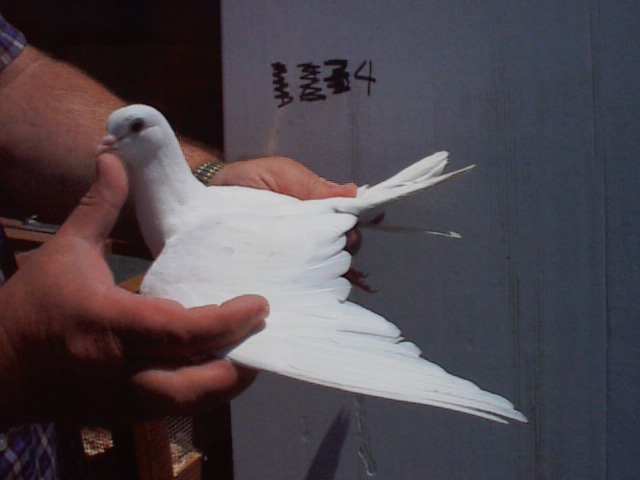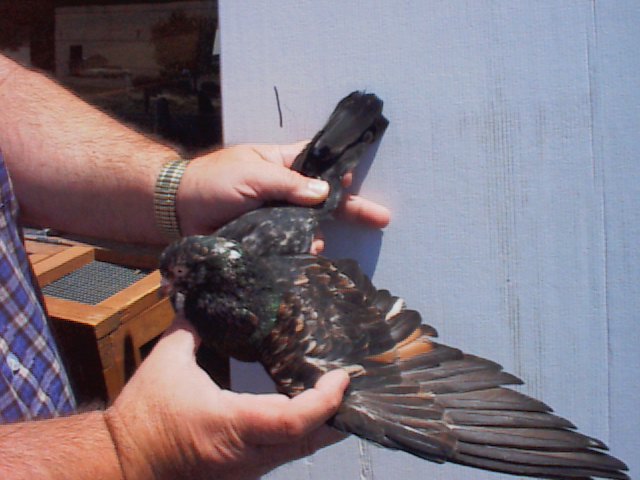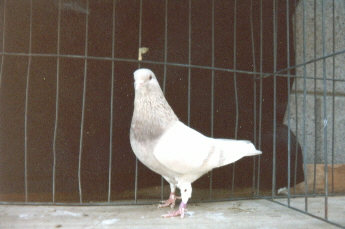


Frank Mosca



Magnani, Stipper, Vielfarbig, Harlekin, Gesprenkled
Almond is what we call this mutation in the English-speaking world. The same mutation is known as Magnani, Stipper, Vielfarbig, Harlekin and Sprenkled in other parts of the globe. Almond's basic effect is a depigmentation or washing-out of the wild-type color [check homo almond photo above] and a tendency to cause flecking or break. This instability of the factor is practically unique among the pigeon mutations known and is the main reason almond (combined with many other mutations for show quality birds) is so prized. Somehow, almond produces feathers which may have up to four colors on them. It seems to accomplish this by turning off the pigment producing ability of the growing feather in a somewhat random pattern. In fact, as some cocks birds age, the instability of almond allows more and more normal pigment production. This can reach limits that make some older almond cocks hard to distinquish as actually being almond. Check the third photo above. One other feature of almond, which makes an almond baby in the nest easy to distinguish even at the moment of hatching from its wild-type siblings, is that almonds are short-downed.
There's one other thing about almond that you should understand. Many people believe only the first bird in the photos above is an almond. Unfortunately, it's not that simple. Almond (the mutation) can be added to almost anything. In fact, "classic" show almond is actually a T-pattern check bird that, in addition to almond, also carries a multitude of factors, including kite bronze, often recessive red, and other darkening factors. By the way, this "classic" color is only classic in the English Shortface Tumbler. It's never been the only phenotype of almond allowed in Modenas (Magnani) nor in the Stipper (from whence almond got its genetic symbol St.) You can have blue bar almonds, ash-red red check almonds, brown almonds, ash-red indigo almonds, spread almonds, and that classic "hidden" almond - DeRoy , i.e., an almond recessive red.
(Above) DeRoy (het almond, homo recessive red)
(Right) Almond, recessive red, dilute
In this article, we are going to discuss almond, and its various alleles.
Don't panic! Heck, I can almost hear the comments. "What's an allele?" "He's getting technical on us, isn't he?" Actually, I'm not - well, not more than a smidgeon. Rather than worrying about exactly what
goes on inside a pigeon's cells, let's simply consider the whole thing a closed system. Only what comes out will interest us, not the innards. It's like the computer, I'm writing this on. Electrons speed though doped silicon in the chip. Various programs at different levels tell the machine to do what I need, but all that's meaningless to me right now. The only think I care about is whether or not a letter appears on screen when my finger depresses a key.
In like manner, we don't normally care about what goes on inside the bird, so long as what comes out is what we're looking for. So again, I ask. What's an allele? An allele is an alternative. It's one of two, or three, or more things which can fit into a particular pair of slots and only into that pair of slots. Since the slots we're talking about are situated on a double strand of material somewhat similar to a ladder and since these slots can be considered to be the holes in which the ladder rungs sit, that gives us two possible places for our alternatives to sit - one on each side of the uprights. An allele may fill in either or both of these holes and may exist in any combination of the possible alternatives present.
Say we've got only two alternatives for one ladder rung section; alternative W and alternative +. We could have the slots filled in only four ways -- either as (W-W); (+-W); (W-+); or (+-+).The only time this double slot idea doesn't hold up is when the factor under discussion is sex-linked. In that case, while it still holds true for male pigeons, it doesn't for females. Hens, again for reasons we're not going to go into today, have only one slot available for sex-linked factors and one of these sex-linked factors (surprise!) is Almond and its alleles. So while a cock may may sometimes carry one of his sex-linked alleles hidden -- (but NEVER almond since he can only carry hidden a recessive sex-linked allele) -- until it's uncovered in one of his youngsters, a hen can't do so. By seeing what she is, we already know her allelic makeup for that sex-linked slot. We may not always have that information for the cock without doing a breeding test or searching pedigree data.
Many, perhaps most, of our birds' features have possible alternative selections for them. Take the three pigments: brown, wild-type (blue/black) and red (in its Ash-red mutation). These three are alleles of each other and just also happen to be sex-linked. (Technically, we should say only brown and Ash-red are sex-linked, wild-type is not sex-linked since blue-black is the standard (wild-type) and everything is referred to that, but I don't want to get too confusing for you here.) The pattern series: barless, wild-type (bar), and checker are alleles to each other and not sex-linked. Alleles exist as well for hue (amount of pigment present in a feather). Dilute, pale and wild-type (intense color) are allelic to each other. Again, these particular alleles just happen to be sex-linked. An important point to note is that each allele is ONLY an alternative to those in the same set or series and NOT to any other. Alleles for pigment (brown, wild-type (blue), Ash-red) can not plug into the spots for pattern. Neither can the alleles for hue plug into the spot for crest/non-crest or muff/non-muff. Those we've mentioned aren't the only groups either.
There are literally thousands of allelic groups. Alternatives to such things as blood type, marking, eye color, feather length, beak size, shape, and thickness, etc., exist. The problem is, we don't yet know what many of them are, how they work, or their exact order of inheritance. We don't even know yet if some traits are inherited as single genes, multi-genes, supergenes or something else. Heck, there's lots more we don't know than we do. If we did, we could simply plug in what we needed for the type of bird we wanted. For those alleles that we do know about, though, that can be done. In fact, it often is done by each of us as we breed for a particular color, pattern or marking.
The spot (locus) on the sex-chromosome where Almond mutated from the wild-type condition also has a set of alleles. Presently, we are sure of at least five, which have been symbolized, and there is a possibilty of a few more which are being looked at right now. The St sequence is as follows from left to right, from more recessive to more dominant:
wild type (+) - (Chalky) - (Frosty) - Sandy (StSa) - Faded (StF)- Qualmond (StQ)- Hickory (StH)- Almond (St).Chalky and Frosty have not, as yet, been given genetic symbols. I've enclosed them in parentheses because people are still working out their exact positions in the dominance sequence. While they do seem to be on the lower end of the dominance scale, their exact placement may never be worked out. This is because following phenotypes [the way a bird looks} and distinguishing one allele from another is extremely difficult. Another problem is that St shows a definite positional effect regarding color of the bird. This effect hinges on what chromosome the St gene is.
In heterozygous Ash-red Almond cocks, for example, if the almond gene is on the chromosome with blue/black, almost no break occurs other than red flecking. On the other hand, if the almond gene is on the chromosome with Ash-red then lots of black shows and this black increases radically with age. Paul Gibson, editor of Pigeon Genetics, News, Views and Comments, presently has a nine year old heterozygous Ash-red Almond cock which now looks to be a blue/black check with only some almond showing in the head. I'm sure the same positional effect likely holds holds true for all the St alleles.
Almond is fairly widespread among pigeon breeds, though it's not always combined with the other mutants which make it the "classical almond" coloration of either the English Shortface Tumbler (originally called the Almond Tumbler) or the Danish Stipper. In fact, when you see Almond alone, i.e., without these other mutants present, it makes it much easier to see its relationship to its alleles.
All these alleles show their effect on the bird's basic pigment. Since there are three pigments: brown, blue/black (wild-type) and red, that means we can have a bird which is brown almond, or blue/black almond, or Ash-red almond. If an almond also happens to be a bird which carries homozygous recessive red, we have what is known as a Deroy (almond recessive red). We may also have a brown faded, a blue/black faded, or an Ash-red faded, etc. However, to avoid being bogged down in more minutia than the subject warrents, any further references to almond alleles in this article will refer only to birds showing that expression on a blue/black base pigment rather than brown or red.
Hens and those cocks which get only a single dose of almond tend to be a somewhat light yellowish buff color with flecks of darker color across the body. Cock birds which get a double dose of almond (homozygous) are very light, almost white, with some color about the neck. They usually have poor vision due to distorted or damaged iris and may also show "bladder-eye". If it weren't for this severe eye damage and the fact most double-dose almond cocks die before leaving the nest (the reason breeders for millenia have said not to pair almond to almond); the color difference between the homozygous cocks and the hemizgyous hens might well have been exploited centuries ago to sex young in the nest. However, if the truth be told, I doubt it would have happened. An almond allele (Faded) which does allow exactly this differentiation has also existed for centuries and was not exploited in this fashion until this century when three scientificially minded individuals, Wendell Levi, W.F. Hollander and W. H. Bernshouse, realized its potential.

Faded Brown Bar hen
These three recognized Faded as something different in the 1930's. Testing showed cock birds, like almonds, are also very light with color only around the neck. However, they have no vision or viability problems. Hens, due to all that cell stuff we're ignoring, get only one Faded allele and are darker and easily told from the cocks even at hatching. This color difference is the basis for the auto-sexing squabbing breeds which have been developed in this century. Perhaps next to make its auto-sexed appearance in the U.S. will one of the Spanish pouters, the Gaditano. In 1992, I discovered that birds I imported the previous year from Spain carried Faded as part of their genetic makeup. Faded hens paired to heterozygous faded cocks should produce some homozygous faded male youngsters. These paired back to their mother or any faded hen will begin auto-sexing.
The Gaditano also carry another almond allele, Qualmond. This allele was recognized as unique by Joe Quinn and was at first known as Quinn's Almond, hence Qualmond. This particular allele tends to have a bluer expression of ground color than does almond and seldom shows much flecking.
All the almond alleles have provided us with material to create beautiful pigeons. Combined with various other mutations such as recessive red, T-pattern Check, the various bronzes, etc., they've given us some of the most exquisitely colored breeds in the world. Breeders who deal with any of these alleles are truly artists who use living material as their medium. Combining all the necessary modifiers to produce specimens which can compete in the show ring takes time, skill, and a bit of luck. The time taken though is well spent since it produces birds which surely rank near the pinnacle of the breeder's art. Others beside me must think so, too, since within the last twenty years, I've seen many breeds which historically have never had almond in their gene pool being "almondized."
I've seen almond Norwich Croppers, almond English Trumpeters, almond Indian Fantails, almond Chinese Owls, almond West of England Tumblers, almond Jacobins, almond and faded Racing Homers, almond and qualmond Long Faced Tumblers, almond Old Dutch Capuchines and even almond Kormorner Magpied Tumblers. Keep it up, folks, but don't forget all those necessary modifiers and other mutations if you want the "classical almond" color. In the meantime, enjoy those almond alleles.
This page was updated 12 Sept. 1997 to
reflect some corrections and also some comments from Ken Davis
and W. F. Hollander
Also updated: 06/19/01
Copyright 1997 by Frank Mosca. This work may be downloaded or copied for non-commercial individual use only. All other rights under copyright are retained by the author. I hold no copyright for any photo above.
almond,pigeons,homers,racers,show birds,show pigeons,pigeon shows,fancy pigeons,pigeon fancy,pigeon sport,sporting birds,racing homers,carrier pigeons,carriers,kinds,lahores,rollers,tumblers,Birmingham,Birmingham rollers,doneks,wutas,kings,nuns,Frank Mosca,W. F. Hollander,pigeon genetics,genetics,pigeon biology,pigeon information,lost pigeons,found pigeons,feral pigeons,C. livia,columba,Columba livia,Tauben,Duiven,colombo,pigeon voyageur,pigeon breeding,breeding pigeons,pigeon breeds,homing pigeon clubs,racing pigeon clubs,pigeon clubs,pigeon organizations,pidgins,pidgeons,Farbentauben,color pigeons